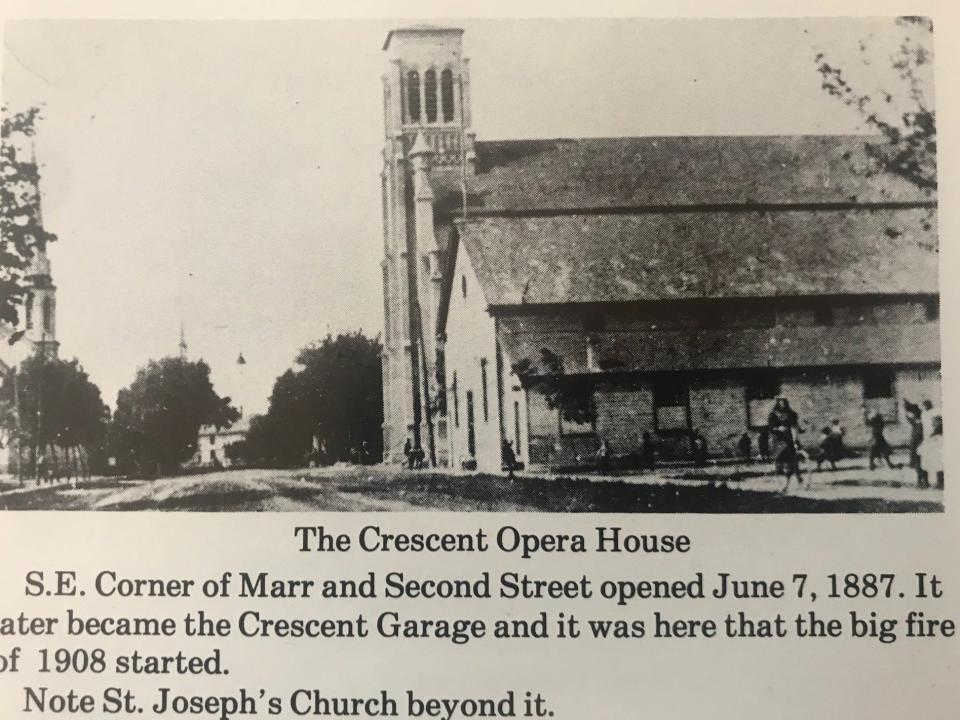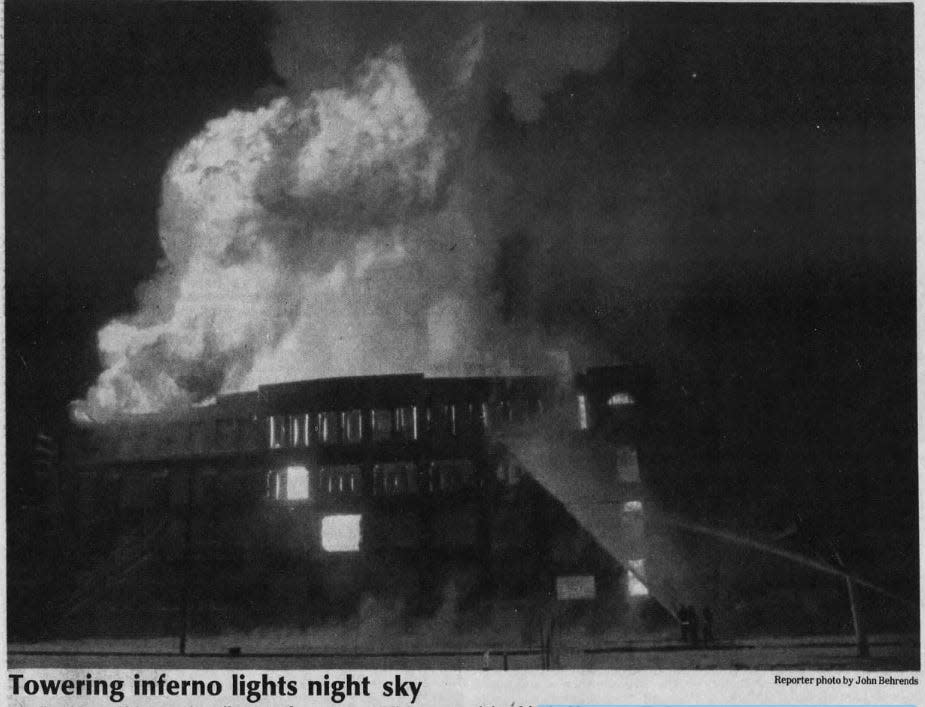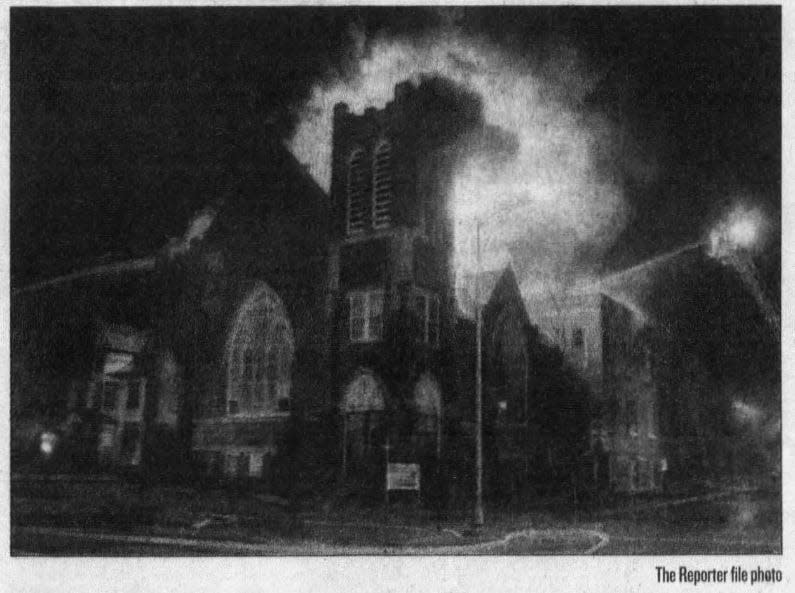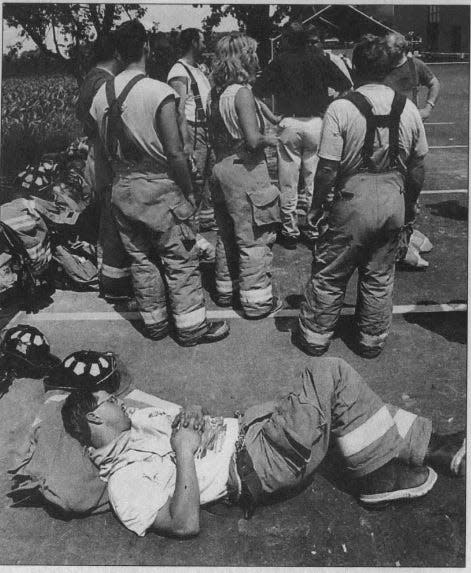Remember when West Ice and Storage burned down? These Fond du Lac landmark fires made history.
FOND DU LAC — The Fond du Lac area has many landmarks of which to be proud, but how many have been lost to tragedy?
One of the city's most famous fires occurred in 1908, known as "the night the churches burned," although it had started in an old opera house.
The Crescent Opera House opened in 1887 on Second and Marr streets with Shakespeare’s classic, “As You Like It,” starring Helena Modjeska. At the time, it was in close proximity to St. Joseph's Church and hosted a number of productions and the very start of 20th-century films.

However, the theater closed in 1906 because of the opening of another theater nearby on Sheboygan Street. At that time, the theater building was converted into an automobile garage.
On Sept. 25, 1908, containers of gas in the building exploded, and a strong wind carried sparks to the roof of St. Joseph's Church, according to The Reporter archives.
The fire spread to the Ulysses S. Grant School and at least three other churches, up to two blocks away.
Fire crews tamed the blaze by 2 a.m., but it had made its mark as the most dramatic fire in Fond du Lac history.
More 'Remember when ...': Remember when there was a sweet shop near the Retlaw Theatre? Here's the story of Caramel Crisp Shop
Three warehouses were wiped out by fires in the span of five years in the 1960s, starting with the Dallman and Cooper Supply Company on Third Street in 1964, during which smoke billowed 200 feet high and fighting the fire proved risky because of blasts from exploding ammunition, pressurized cans and highly flammable materials.
In early 1968, the Nick Schneider Firm two blocks away on Fourth Street was destroyed after the fire department battled the flames for two hours in near zero-degree temperatures, including where the fire spread to two other buildings.
American Wire Products Corporation on Brooke Street was the last to go after the ceiling of a first-floor office caught fire in 1969. The fire injured two firefighters and displaced 20 employees.
Also on Brooke Street, West Ice and Cold Storage burned down the night of March 19, 1989, in front of a crowd of thousands, and the "towering inferno" could be seen for miles, according to archives.

Onlookers first noticed heavy smoke disrupting traffic that evening, and by the time the flames were visible, 14 police officers had to run crowd control on up to 3,000 people who rushed to watch.
The five-story building was filled with construction materials, as it was being used for storage for L.H. Construction Inc., including the equipment and materials for several of the company's upcoming projects. There were no utilities or boiler facilities to start the fire, which was the first indication to the owners the fire was arson.
Another indication prior to the fire being determined intentional was the back doors had been kicked open before firefighters arrived. The owners told The Reporter at the time they had to kick kids out of the building on multiple occasions.
More 'Remember when ...': Remember when Ralph & Mama's served its famous chili? The owners are memorialized next to Johnson Street bridge.
The adjacent Bestt Rollr building was damaged in both the West Ice and American Wire Products Corporation fires, 20 years apart.
In 1996, two teenage girls were convicted for the fire at First Presbyterian Church at the corner of Marr and Sheboygan streets after they left a candle burning in the building, and the resulting fast-burning blaze caused $2.4 million in damage.

Firefighters poured about 2,000 gallons of water a minute onto the church, but not before struggling to get water out of the nearest hydrant after they arrived at around 3 a.m. Charred debris flowing out of the flooded church clogged the catch basins as crews worked well into the morning.
Police found an incriminating letter in the rubble that had been passed between the girls, saying the church would burn.
The church was one that had mostly survived in 1908, but this time the church had to relocate to Fourth Street.
Quad Graphics in Lomira is still standing, but in July 2002, more than 300 firefighters from 55 departments battled a fire for nine days in one of the plant's buildings.
An automated racking structure collapsed, which caused part of the 10-story building to crumble and catch fire, destroying about 30,000 pallets of magazine and catalog pages and causing the death of one person, Keith Freiburg, a 22-year-old maintenance worker who was trapped in a car next to the building.

Attending the fire required the crews to clean as they went, spreading and clearing the debris so it wouldn't stay warm. Eight-person crews were on standby in eight-hour shifts, including Oakfield crews that covered the Brownsville station while local crews stayed at Quad Graphics.
Brownsville's fire engines ran continuously, contributing to about 8,000 gallons of diesel fuel that was used for equipment by the seventh day.
More history: Leap Day headlines
Feb. 29, 1972: A Fond du Lac food co-operative, called The People's Co-Op, announced the formation of its committees, one step closer to the co-op's fruition. Membership was promised to be open to the public for $5 in yearly dues, with a goal to make food and household items available at a lower cost than retail and grocery stores.
Feb. 29, 1984: A pair of thieves stole $2,074 worth of women's jeans from H.C. Prange at Forest Mall, which is worth over $6,000 today. An employee reported seeing the two enter the store at 10:30 a.m., but apparently becoming nervous and leaving soon after. They returned after noon and made off with the jeans.
Feb. 29, 1996: The city council asked the Yacht Club to reconsider its offer to repair a dock and pier that had fallen into disrepair after the club rescinded its initial offer following backlash from one council member and some community members. Other council members advised the assenting member "not to look a gift horse in the mouth."
Feb. 29, 2000: Amtrak first unveiled a proposal for a daily round-trip passenger train servicing Fond du Lac as an extension of the daily Hiawatha commuter train between Milwaukee and Chicago. The hope was to carry express freight as well to make passenger rail service more affordable, and eventually expand all the way up to Green Bay.
"Remember when ..." is a bi-weekly column from Streetwise Reporter Daphne Lemke that looks back at businesses of Fond du Lac's storied past. Tell her what you'd like to see next by emailing dlemke@gannett.com.
This article originally appeared on Fond du Lac Reporter: Fond du Lac lost several businesses and landmarks to historical fires

